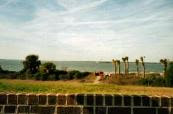 |
| Prairie Grove Battlefield State Park |
The 148th anniversary of the Battle of Prairie Grove, Arkansas - one of the largest Civil War battles fought west of the Mississippi River - will be marked by a weekend of activities and battle reenactments.
The actual battle took place on December 7, 1862, when Confederate General Thomas Hindman drove north out of the Boston Mountains between two weeks of the divided Union Army of the Frontier. Hindman hoped to defeat one division of the Federal army before it could be reinforced by the other, allowing him to overwhelm the larger force and retake Northwest Arkansas for the Confederacy.
At its height, the battle involved some 22,000 soldiers fighting along miles of a low ridge. An estimated 2,700 men and boys were reported killed, wounded or missing. You can read more about the battle itself at www.exploresouthernhistory.com/ArkansasPG1.
Prairie Grove Battlefield State Park is located on U.S. Highway 62 in Prairie Grove, 12 miles southwest of Fayetteville, Arkansas (if coming via Interstate 540, take the Farmington exit).
Here is a full schedule of planned events for both days. Activities will begin tomorrow morning (Saturday, December 4th) and continue through Sunday (December 5th).
Saturday, December 4th - All Day - Sutlers Row open along the historic stone wall.
Book signing starting at 9 a.m. - Fields of Blood: The Prairie Grove Campaign by Dr. William Shea - Latta Barn.
7:00 A. M. – Reveille. (A bugle call at about sunrise signaling the first military formation of the day)
8:00 A. M. – 5:00 P.M. – Latta barn is open with gift shop & book store.
9:00 A. M. -11:00 A. M. - All Camps open to public.
9:15 A.M. - Company Drill (by maneuver companies) at Drill Area
10:00 A.M. – 4:00 P.M. - Latta kitchen open with fireplace cooking demonstrations by Janice Neighbor.
10:00 A.M. – 3:00 P.M. – Demonstration of the traditional art of spinning thread, and discuss the basics of making cloth by members of Wool and Wheel Handspinners at Morrow House.
10 A. M. – noon - The Civil War Garden - Washington County Master Gardeners - Inquire in the Latta House
10 A. M. - "A Call to resist the invading abolitionist hordes” - Porch of the Latta House by Ian Beard, Old Statehouse Museum
10:00 A.M. - Bayonet Drill (optional and open to all infantry troops) at Drill Area.
10:30 A.M. - Battalion drill and arms inspection by park personnel - Weapons inspection. Public viewing near respective camps drills area.
12:00 P. M - "A plea for the citizenry of Arkansas to retake her rightful place in the Union of States" - Porch of the Latta House by Ian Beard, Old Statehouse Museum
12:00 P. M. – Spectator viewing line open preparing for Demonstration.
12:15 P.M. - Form for battle, arms inspection by park personnel – Public viewing from Spectator Safety line.
12:45 P.M. – All camps closed to public, movement of troops & spectators to battlefield area
1:00 P.M. – Presentation marking 148th anniversary of the battle.
1:10 P.M. - Explanation of battle and last reminder about crowd safety
1:15 P.M. - Battle demonstration near the Borden House. Battle commences.
2:00 P.M. - Wounded gathered to hospitals for medical demonstrations by US & CS surgeons. Battle ends.
2:30 P.M. – 5:00 P.M. – All Camps re-open to the public.
3:30 P.M. - Period "rounders" (baseball) game at Ozark village by church and school.
5:00 P.M. – All Camps closed to public, last self guided tour ends
7:00 P.M. - Period Dance – Location Hindman Hall
Sunday, December 5th - All Day - Sutlers Row open along the historic stone wall.
7:00 A. M. – Reveille. (A bugle call at about sunrise signaling the first military formation of the day)
8:00 A. M. – 5:00 P.M. – Latta barn is open with gift shop & book store.
8:00 A. M. to 11:00 A. M. – Late arrivals to register at Latta barn.
8:30 A. M. – Generals & Chiefs of Staff Call - Joint Federal/Confederate– Location: Latta Barn
9:00 A. M. -11:00 A. M. - All Camps open to public, self guided tour begins.
9:15 A.M. - Company Drill (by maneuver companies) at Drill Area.
10:00 A.M. - Period Church service at log church & catholic mass at the Jim Parks Shelter
10:00 A.M. – 4:00 P.M. - Latta kitchen open with fireplace cooking demonstrations by Janice Neighbor.
11:00 A.M. – 2:00 P.M. - Demonstration of the traditional art of spinning thread, and discuss the basics of making cloth by members of Wool and Wheel Handspinners at Morrow House.
11:00 A.M. - Bayonet drill (special demonstration by picked squad only) at Drill Area.
11:00 A.M. - Battalion drill and arms inspection by park personnel - Weapons inspection. Public viewing near respective camps drills area.
12:00 P. M. – Spectator viewing line open preparing for Demonstration.
12:15 P.M. - Form for battle, arms inspection by park personnel - Public viewing from Spectator Safety line.
12:45 P.M. – All camps closed to public, movement of troops & spectators to battlefield area.
1:00 P.M. – Presentation marking 148th anniversary of the battle.
1:10 P.M. - Explanation of battle and last reminder about crowd safety
1:15 P.M. - Battle demonstration near the Borden House. Battle commences.
2:00 P.M. - Wounded gathered to hospitals for medical demonstrations by US & CS surgeons. Battle ends.
2:15 P.M. – All camps open to public, no tours.
3:00 P.M. – End of reenactment – Closing of all encampments to public.





































